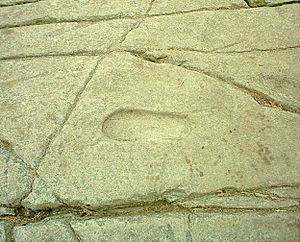Áedán mac Gabráin facts for kids
Áedán mac Gabráin (pronounced like AY-dan mac GAV-ran) was a powerful king of Dál Riata. He ruled from around 574 AD until about 609 AD. His kingdom, Dál Riata, was located in what is now Argyll and Bute, Scotland, and parts of County Antrim, Ireland. Áedán was the son of Gabrán mac Domangairt.
He lived at the same time as Saint Columba, a very famous Irish monk. Many stories about Áedán come from books written about Saint Columba, like Life of Saint Columba. Áedán also appears in old Irish poems and stories.
Old Irish records tell us about Áedán's battles against his neighbors. He fought in Ireland and northern Britain. He even led trips to the Orkney Islands and the Isle of Man. A writer named Bede recorded that Áedán was badly defeated by Æthelfrith of Bernicia at the Battle of Degsastan. After this defeat, Áedán might have stepped down as king. He is believed to have died on April 17, 609 AD.
Contents
Who Were Áedán's Neighbors?
Áedán was the main king in Dál Riata. He ruled over smaller kings from different tribes. Dál Riata was divided into three main groups, each named after an important ancestor. These included the Cenél nGabráin, who were Áedán's own family. They ruled areas like Kintyre and Bute.
Outside Dál Riata, Áedán's neighbors in northern Britain were the Picts and the Britons. The Britons lived in parts of what is now northern England and southern Scotland. The strongest British kingdom was Alt Clut. Later in Áedán's life, the Anglo-Saxon kingdom of Bernicia became very strong in northern Britain.
In Ireland, Dál Riata was part of Ulster. Other groups in Ulster included the Cruithne. Beyond Ulster, the Uí Néill were a powerful group, often unfriendly to Ulster.
Áedán's Time as King

Áedán became king in 574 AD, after his uncle Conall mac Comgaill died. He was about 40 years old. Some stories say that Saint Columba actually chose Áedán to be king. This was a very early example of a king being "ordained" or officially blessed in Britain and Ireland.
In 575 AD, a very important meeting happened called the "great convention of Druim Cett". Áedán and Saint Columba were both there. One big decision made at this meeting was about Dál Riata's place in the world. It was agreed that Dál Riata's navy would help the Uí Néill. But Dál Riata would not have to pay taxes to them. Also, warriors would only be sent from the Dál Riata lands in Ireland.
This agreement was probably made because another king, Báetán mac Cairill, was a threat. Báetán had made the king of Dál Riata pay him respect. After Báetán died in 581 AD, Áedán fought on the Isle of Man. He may have driven out the people from Ulster who had taken it over.
Around 580 AD, Áedán also attacked the Orkney Islands. These islands had been under the control of Bridei, the King of the Picts.
Áedán also fought battles closer to home. He had a successful campaign against a tribe called the Miathi. But sadly, two of his sons, Artúr and Eochaid Find, died in this battle. This battle might have happened around 590 AD.
An old prophecy says Áedán fought against the Picts for thirteen years. One recorded battle between Áedán and the Picts happened around 599 AD. Áedán was defeated in this fight, and more of his sons died.
There are also stories from Wales about battles between Áedán and King Rhydderch Hael of Alt Clut. It seems they were allies for a while, but then they started fighting. One Welsh story says Áedán's attacks on Alt Clut were some of the "three unrestrained plunderings of Britain."
The Battle of Degsastan and What Happened Next
The Battle of Degsastan was not the first time Áedán fought the Bernicians. His son Domangart died in a battle against the Saxons earlier.
Bede wrote that Áedán was worried about the growing power of Æthelfrith, the king of Bernicia. The Battle of Degsastan was a huge victory for Æthelfrith. Bede said that after this battle, no Irish king in Britain dared to fight the English again. Even though Æthelfrith won, he also lost many men. His brother Theodbald was killed in the battle.
After this big defeat at Degsastan, the old records don't say much about Áedán for about six years. He died around April 17, 609 AD. Some sources say he was 74 years old. One old text suggests he was no longer king when he died. Another says he was forced to give up his kingship. Some believe he was buried in Kilkerran in Kintyre.
Áedán's Family
Áedán was followed as king by his son, Eochaid Buide. Saint Columba had predicted that Eochaid's older brothers would die before their father. Áedán had several other sons, including Artúr, Eochaid Find, Tuathal, Bran, Baithéne, Conaing, and Gartnait.
The main line of kings from Áedán's family came from Eochaid Buide. But the descendants of another son, Conaing, also fought for the throne for many years.
It's also been suggested that Áedán's son Gartnait might be the same person as Gartnait son of Domelch, who was a king of the Picts. This idea is based on how Pictish kingship might have passed through the mother's side of the family.
Less is known about Áedán's daughters. One daughter, Maithgemm, married a prince named Cairell. We don't know the names of Áedán's wives.
See Also

